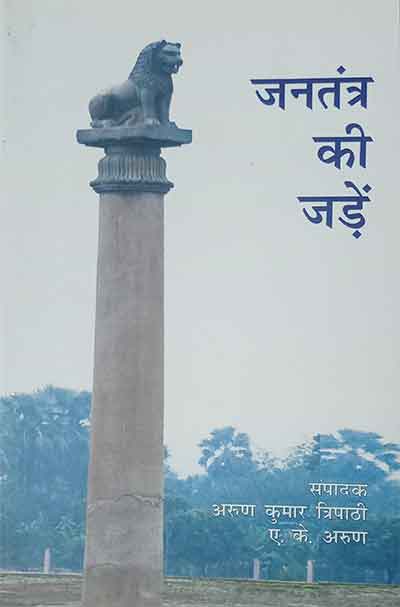————————————————————————————————————————-
NARMADA GHATI SE BAHUJAN GATHAYEN
Editors: Ojas S. V., Madhuresh Kumar, Vijayan M. J. and, Joe Athiyali
Translation: Chinmay Mishra
New Delhi, April 2022, Navarun, Pp. 247, Price Rs. 350/-
————————————————————————————————————————–
 Narmada Bachao Andolan (NBA, Save Narmada Movement) is one of the longest drawn (35 years) people’s movement against ‘development’ at the cost of people and nature in India. While the contributions to the movement by middle class activists like Medha Patkar and Sylvi are well known, contribution by affected villagers of Madhya Pradesh, Maharashtra and Gujrat are not known much. This book deals with this aspect of the movement.
Narmada Bachao Andolan (NBA, Save Narmada Movement) is one of the longest drawn (35 years) people’s movement against ‘development’ at the cost of people and nature in India. While the contributions to the movement by middle class activists like Medha Patkar and Sylvi are well known, contribution by affected villagers of Madhya Pradesh, Maharashtra and Gujrat are not known much. This book deals with this aspect of the movement.
The main body of the book has 14 long interviews done with these villagers, in an open atmosphere, in the language of the interviewee. These languages are: Pavari, Bhilali, Marathi, Nimari and Hindi. The interviews took six months to translate and edit. Among the 14, 8 are from Madhya Pradesh, 5 are from Maharashtra and one from Gujrat. Three are women – two from MP and one from Maharashtra. Most of them have very little formal school education though one is a graduate from the neighboring small town.
A Few Profiles
- Punya Vasave, Rehabilated Place: Somwal, Maharashtra. Original Village: Bamni, Maharashtra.
Punya belongs to the first group which accepted rehabilitation. But he is still associated with the original village and activities of the movement. In spite of the rehabilitation he is active and participates in people’s struggle regularly.
- Baba Maharia, Village Jalsindhi, Madhya Pradesh. An ideological thinker. A leader of Narmada Valley accepted by all. He refused to accept rehabilitation land because it was not sufficient for the whole village. Fought bravely and came forward to lead in the face of very adverse situations like his house getting drowned. Played an important role in saving the forests.
- Kamala Yadav, Village: Chhota Barda, Madhya Pradesh.
The whole Narmada valley is her family! She is a woman leader of Nimar. Faced many times police atrocities. Brings people together, is brave and can talk back to anyone. In spite of physical limitations travelled all over the valley.
- Raiji Kaka, Rehabilated Place: Kundia Kamboia Kuan, Gujarat. Original Village: Gadher, Gujrat.
Although he went to a rehabilitation place long back but seeing the problems there he went back to his original village. First he was associated with such organizations who helped the government to take villagers to rehabilitation places. He felt that they were all betraying the people. So he left them and joined the NBA. He is a fearless leader of Gujrat. He exposer the government’s model rehabilitation plan and showed that the government sent people of one village to different places.
- Rehamat, Village Chikhalda, Madhya Pradesh.
An ideological encyclopedia of Madhya Pradesh! A full time activist of the movement for many years. Educated (from the neighboring town of Badwani), soft spoken, very careful in planning the programme of the movement, expert in getting information out of government documents.
Issues Raised and Discussed
All the narratives, though individually rich and varied in personal details and personal involvement in the movement, nevertheless have something common in them. Since this review cannot, for lack of space, discuss each interview, has to limit itself with discussing these common points.
- They lived in the valley peacefully, in a self-sufficient local economy. They needed very little money. The land (agriculture) and forest gave them and their animals plenty.
- With the beginning of the dam construction activities their life became hell. Government employees came to survey and to take over forest lands. They gave scanty information and promised everybody will be rehabilitated.
- At every stage they came across disinformation, outright lies and corruption. When the struggle began they faced repression, brutality and jail terms.
- Although the dam got finally built, the achievements of the movements are also huge. It has built a most formidable and large mobilization of people over a long period of 35 years.
- The dam project was repeatedly halted because of the movement. The movement got the World Bank to Review its financial support and finally the WB had to ask GOI not to ask for loans. Later World Commission of Dams was formed and the Bank removed its support to many other dams for many years.
- In 1998 some activists struggling against Pakmun Dam on Mekong in Thailand came to see NBA movement. Later they continues the struggle and in 2003 the Thai government had to back out from building the dam.
- However there are also several ‘victories’ of the movement in the society of Narmada Valley. The foremost is the participation of women in the movement. Ghunghat (covering of face) vanished and cast discrimination reduced considerably. In spite of the family responsibilities they took part in the movement bravely in mobilizing people, confronting the authorities and the police, faced brutalities and jail terms.
- They have done important work in the field of education by opening Jeevanshaalas. To begin with they created schools for remote village children where there were no schools. Then as the name suggests they brought education closer to life. With their slogan of ‘struggle and studies go together’ the children sat in front of the bulldozers.
- The experience of rehabilitation taught them the horrors of city life, money economy and urban pollution.
- They brought the question of development in the forefront at the national level. With this came the critic of industrialization, pollution and chemical farming. So the ideas of organic farming and local self-government came up.
Concluding Remarks
Lenin once said that the proletarian revolution culminates in a victory through a series of defeats. Each defeat teaches lessons, transforms people and gets them ready for the ultimate victory. The NBA represents such a process. Although they lost the main battle of stopping the dam, get adequate compensation etc. but gained in terms of social transformation. These are in terms of self-government, self-management of education and health care, removal of untouchability, women’s liberation and development of a sense of community. Even in the mainstream discourse they introduced a critic of development, a critic of big dams, industrialization which pollutes and harms, chemical agriculture and so on.
The present order is bound to collapse not only due to people’s movement but due to coming together of several crises. These are: global warming and climate crisis, ecological degradation, depleting mineral resources including petroleum and wars for the control of resources. In such a situation of collapse, the people of Narmada valley are ready to take over the control of their lives, communities and resource in their own hand and manage them. They will manage themselves in such a way that all the other species in Nature will also survive.
Finally a word of apology to the interviewees. To begin with the book itself is a translation from the original language into Hindi. To some extent it missed the feeling and energy of the people. This review in English is not only twice removed, it being so short also misses a lot of the content and energy of the book. The book can make a lot more sense to those who can read Hindi and are people of the valley or who have been part of the movement or have visited the movement and the valley extensively. This reviewer has visited some parts of the valley several times since the early fifties, has visited the movement once and have met several activists over a period of time. It is hoped that that the readers will take more interest in the issues raised and contribute to make this devastated world a bit better.
T. Vijayendra (1943- ) was born in Mysore, grew in Indore and went to IIT Kharagpur to get a B. Tech. in Electronics (1966). After a year’s stint at the Saha Institute of Nuclear Physics, Kolkata, he got drawn into the whirlwind times of the late 60s. Since then, he has always been some kind of political-social activist. His brief for himself is the education of Left wing cadres and so he almost exclusively publishes in the Left wing journal Frontier, published from Kolkata. For the last nine years, he has been active in the field of ‘Peak Oil’ and is a founder member of Peak Oil India and Ecologise. Since 2015 he has been involved in Ecologise! Camps and in 2016 he initiated Ecologise Hyderabad. He divides his time between an organic farm at the foothills of Western Ghats, watching birds, writing fiction and Hyderabad. He has published a book dealing with resource depletions, three books of essays, two collections of short stories, a novella and an autobiography. Vijayendra has been a ‘dedicated’ cyclist all his life, meaning, he neither took a driving licence nor did he ever drive a fossil fuel based vehicle. Email: [email protected]

















































